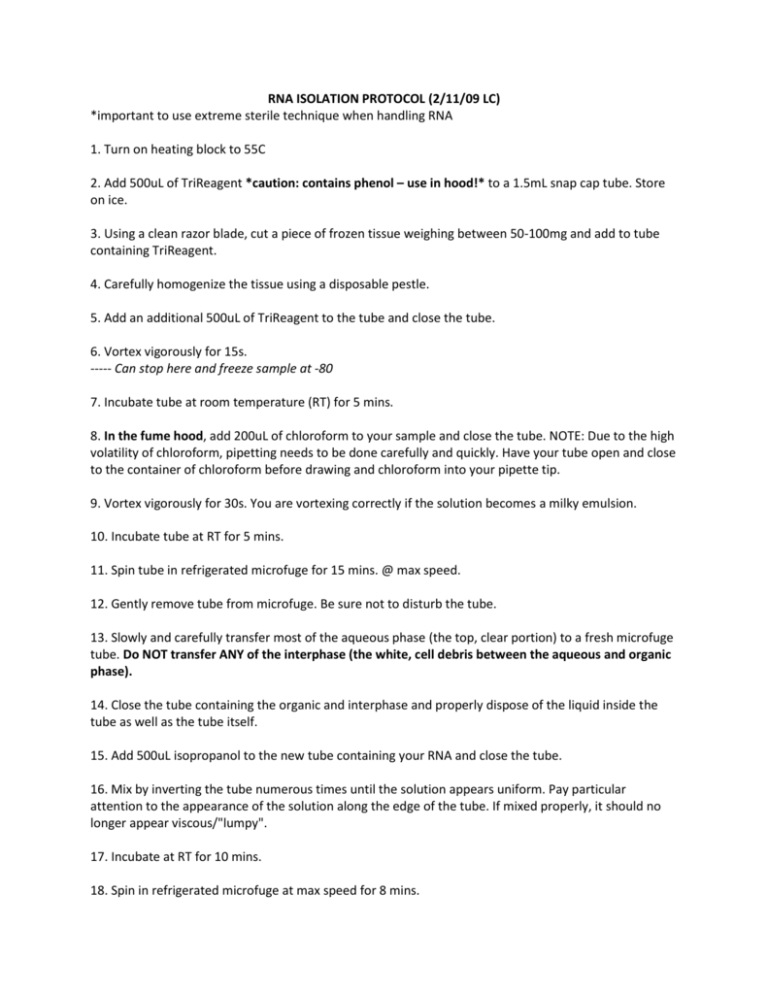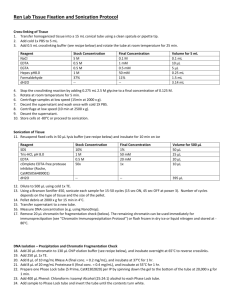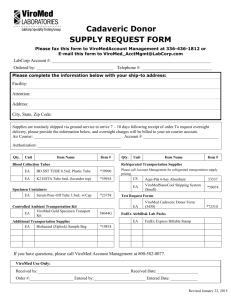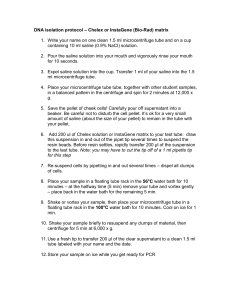RNA isolation & RT protocol
advertisement

RNA ISOLATION PROTOCOL (2/11/09 LC) *important to use extreme sterile technique when handling RNA 1. Turn on heating block to 55C 2. Add 500uL of TriReagent *caution: contains phenol – use in hood!* to a 1.5mL snap cap tube. Store on ice. 3. Using a clean razor blade, cut a piece of frozen tissue weighing between 50-100mg and add to tube containing TriReagent. 4. Carefully homogenize the tissue using a disposable pestle. 5. Add an additional 500uL of TriReagent to the tube and close the tube. 6. Vortex vigorously for 15s. ----- Can stop here and freeze sample at -80 7. Incubate tube at room temperature (RT) for 5 mins. 8. In the fume hood, add 200uL of chloroform to your sample and close the tube. NOTE: Due to the high volatility of chloroform, pipetting needs to be done carefully and quickly. Have your tube open and close to the container of chloroform before drawing and chloroform into your pipette tip. 9. Vortex vigorously for 30s. You are vortexing correctly if the solution becomes a milky emulsion. 10. Incubate tube at RT for 5 mins. 11. Spin tube in refrigerated microfuge for 15 mins. @ max speed. 12. Gently remove tube from microfuge. Be sure not to disturb the tube. 13. Slowly and carefully transfer most of the aqueous phase (the top, clear portion) to a fresh microfuge tube. Do NOT transfer ANY of the interphase (the white, cell debris between the aqueous and organic phase). 14. Close the tube containing the organic and interphase and properly dispose of the liquid inside the tube as well as the tube itself. 15. Add 500uL isopropanol to the new tube containing your RNA and close the tube. 16. Mix by inverting the tube numerous times until the solution appears uniform. Pay particular attention to the appearance of the solution along the edge of the tube. If mixed properly, it should no longer appear viscous/"lumpy". 17. Incubate at RT for 10 mins. 18. Spin in refrigerated microfuge at max speed for 8 mins. 19. A small, white pellet (RNA and salts) should be present. If not, do not fret. Continue with procedure. 20. Remove supernatant. 21. Add 1mL of 75% EtOH to pellet. Close tube and vortex briefly to dislodge pellet from the side of the tube. If the pellet does not become dislodged, that is OK. 22. Spin in refrigerated microfuge at 7500g for 5mins. 23. Carefully remove supernatant. Pellet may be very loose. Make sure not to remove pellet! 24. Briefly spin tube (~15s) to pool residual EtOH. 25. Using a small bore pipette tip (P20 or P200 tips), remove remaining EtOH. 26. Leave tube open and allow pellet to dry at RT for no more than 5mins. 27. Resuspend pellet in 100uL of 0.1%DEPC-H2O by pipetting up and down until pellet is dissolved. 28. Incubated tube at 55C for 5mins to help solubilize RNA. 29. Remove tube from heat, flick a few times to mix and place sample on ice. This will be your stock RNA sample. Don’t forget to quant RNA yield before reverse transcription!! NEXT STEP: Reverse Transcribe RNA to complementary DNA REVERSE TRANSCRIPTION PROTOCOL 1. Mix your stock RNA sample by inverting tube several times. 2. Transfer 25ug of your RNA (.25ug of mRNA) to a fresh PCR tube. Bring the volume up to 5uL with PCR water. If necessary, spin tube briefly to pool liquid. -Add a negative control here. -If you have enough sample to spare and [RNA] is within the 25ug range just use 5ul of RNA (no water). 3. Incubate tube at 75C for 5mins in thermal cycler. 4. Transfer tube IMMEDIATELY to ice and incubate for at least 5mins. 5. Make Master Mix RECIPE PER RXN 4 ul 5x Buffer (AMV RT Buffer) 8 ul dNTPs (10 mM total) 1 ul AMV RTranscriptase 1 ul Oligo dT Primer 1 ul RNase free water Total = 15 ul 6. Add 15ul MM to tube with RNA in it (total volume now 20 ul) 7. Vortex and spot spin 8. Incubate at RT for 10 min 9. Incubate at 37C for 1 hr in thermocycler 10. Heat inactivate @ 95C for 3 min 11. Spot spin and leave on ice or store at –20C






